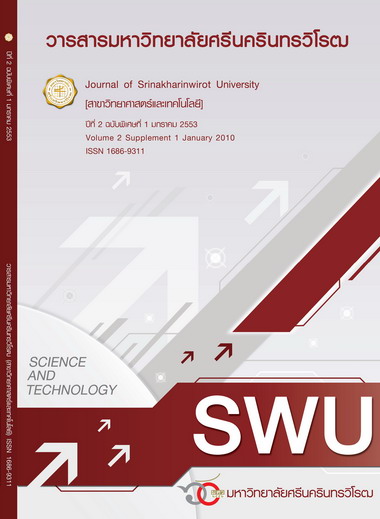ผลกระทบต่อสุขภาพกายจากการสัมผัสพลังงานความร้อนขณะทำงานในกลุ่มคนทำนาเกลือจังหวัดสมุทรสงคราม (PHYSICAL HEAL EFFECTS FROM OCCUPATIONAL EXPOSURE TO NATURAL HEAT AMONG SALT PRODUCTION WORKERS IN SAMUTSONGKHRAM PROVINCE)
Keywords:
Natural heat, Salt production worker, Physical factorAbstract
บทคัดย่ออุณหภูมิของโลกที่เพิ่มขึ้นเป็นสิ่งที่ส่งผลกระทบต่อสุขภาพของคนที่ต้องทำงานกลางแดด การศึกษาภาคตัดขวางนี้มีวัตถุประสงค์เพื่อประเมินขนาดและความรุนแรงของผลกระทบต่อสุขภาพกายและหาความสัมพันธ์ระหว่างการทำงานในสภาพอากาศร้อนกับผลกระทบต่อสุขภาพกายของคนทำนาเกลือในจังหวัดสมุทรสงคราม เก็บข้อมูลระหว่างเดือนเมษายน ถึง สิงหาคม 2552 โดยทำการวัดภูมิสภาพแวดล้อมด้วยดัชนีกระเปาะเปียกและโกลบ (WBGT) รุ่น RSS-214DL แบบรายพื้นที่ จำนวน 18 ตัวอย่าง สัมภาษณ์ข้อมูลส่วนบุคคล ประวัติการทำงาน ลักษณะการทำงาน และอาการที่เกิดขึ้นจากการทำงานในสภาพอากาศร้อน วัดการเปลี่ยนแปลงทางสรีรวิทยาโดยวัดอุณหภูมิร่างกายด้วยเทอมอมิเตอร์ทางช่องหู วัดความดันโลหิต ชีพจรด้วยเครื่องวัดความดันโลหิตแบบดิจิตอล และตรวจระดับความถ่วงจำเพาะของปัสสาวะด้วยเครื่อง Refractometer จำนวน 171 คน ผลการศึกษาพบว่า ค่าเฉลี่ยอุณหภูมิสภาพแวดล้อมการทำงาน เท่ากับ 33.83±0.95 องศาเซลเซียส สำหรับผลกระทบต่อสุขภาพกายของกลุ่มตัวอย่าง 171 คน พบว่า กลุ่มตัวอย่างร้อยละ 35.67 มีอาการที่เกิดจากการทำงานในสภาพอากาศร้อน ในจำนวนนี้อาการที่พบมากที่สุด คือ ร้อยละ 67.18 มีอาการเพลียร้อน ร้อยละ 26.56 เป็นเม็ดผด และร้อยละ 6.25 เป็นตะคริวเนื่องจากความร้อนตามลำดับ เมื่อวิเคราะห์ความสัมพันธ์ระหว่างสภาพความร้อนในการทำงานกับผลกระทบต่อสุขภาพพบว่า ค่าเฉลี่ยระดับความถ่วงจำเพาะของปัสสาวะโดยควบคุมปริมาณน้ำดื่มในขณะทำงานพบว่า แปรผันตรงและมีความสัมพันธ์กันมากกับสภาพความร้อนในการทำงาน (r = 0.89, p-value<0.001) ส่วนอัตราการเกิดอาการแปรผันตรงและมีความสัมพันธ์กันปานกลางกับสภาพความร้อนในการทำงาน (r = 0.76, p-value<0.001) ตามลำดับ ผลการศึกษานี้จะเห็นได้ว่าความร้อนในสภาพแวดล้อมการทำงานส่งผลกระทบต่อสุขภาพกายในกลุ่มคนทำนาเกลือ ดังนั้นผู้ให้บริการด้านอาชีวอนามัยควรตระหนักถึงปัญหานี้และกำหนดมาตรการป้องกันที่เหมาะสมต่อไป
Abstract
As the severity of global warming increases, the occupational exposure to natural heat seems to adversely affect to health of outdoor workers. The objective of this cross-sectional study was to determine both the magnitude and association of occupational health effects among salt production workers in Samutsongkhram province. Data was collected from April to August 2009. The working environment was measured by Wet Bulb Globe Temperature (WBGT) model RSS-214DL in 18 areas of salt production farms. Altogether 171 workers were interviewed fordemographic data, occupation history, job description and health effect. The individual physiological changes from natural heat were measured as follows: body temperature by ear thermometer, vital signs by digital blood pressure monitor and urine specific gravity by refractometer. Results revealed that the average temperature of working environment was 33.83±0.95oC. Of 171 salt production workers, 35.67% had heat-related symptoms including heat exhaustion (67.18%), prickly heat (26.56%) and heat cramp (6.25%), respectively. The correlation between natural heat and physical effect show that the means of urine specific gravity among workers in each area was positively and highly correlated with temperature of working area (r = 0.89, p = <0.001). The rate of symptom was also positively and moderately correlated with temperature of working area (r = 0.76, p-value<0.001). In conclusion, this study demonstrated that occupational exposure to natural heat could potentially be hazardous to health of salt production workers. The occupational health personals should be aware and provide appropriate protective measures in this problem.
Downloads
Downloads
Published
How to Cite
Issue
Section
License
Srinakharinwirot University Journal of Sciences and Technology is licensed Under a Creative Commons Attribution-NonCommercial-NoDerivs 4.0 International (CC-BY-NC-ND 4.0) License, Unless Otherwise Stated. Please Read Journal Policies Page for More Information on Open Access, Copyright and Permissions.



